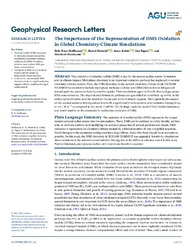The Importance of the Representation of DMS Oxidation in Global Chemistry‐Climate Simulations
DOI: https://doi.org/10.1029/2021GL094068
Persistent URL: http://resolver.sub.uni-goettingen.de/purl?gldocs-11858/9581
Persistent URL: http://resolver.sub.uni-goettingen.de/purl?gldocs-11858/9581
Hoffmann, Erik Hans; Heinold, Bernd; Kubin, Anne; Tegen, Ina; Herrmann, Hartmut, 2021: The Importance of the Representation of DMS Oxidation in Global Chemistry‐Climate Simulations. In: Geophysical Research Letters, Band 48, 13, DOI: 10.1029/2021GL094068.
 |
View/
|
The oxidation of dimethyl sulfide (DMS) is key for the natural sulfate aerosol formation and its climate impact. Multiphase chemistry is an important oxidation pathway but neglected in current chemistry‐climate models. Here, the DMS chemistry in the aerosol‐chemistry‐climate model ECHAM‐HAMMOZ is extended to include multiphase methane sulfonic acid (MSA) formation in deliquesced aerosol particles, parameterized by reactive uptake. First simulations agree well with observed gas‐phase MSA concentrations. The implemented formation pathways are quantified to contribute up to 60% to the sulfate aerosol burden over the Southern Ocean and Arctic/Antarctic regions. While globally the impact on the aerosol radiative forcing almost levels off, a significantly more positive solar radiative forcing of up to +0.1 W m−2 is computed in the Arctic (>60°N). The findings imply the need of both further laboratory and model studies on the atmospheric multiphase oxidation of DMS. Plain Language Summary:
The emission of dimethyl sulfide (DMS) represents the largest natural reduced sulfur source into the atmosphere. There, DMS can be oxidized to sulfur dioxide, sulfuric acid, or methane sulfonic acid modifying the radiative properties of aerosol particles and clouds. DMS oxidation is represented in chemistry‐climate models by a limited number of very simplified reactions. Small changes in the parameter settings can have large effects, that's why these should be as accurate as possible. In this study, the DMS chemistry in ECHAM‐HAMMOZ was upgraded. Sensitivity simulations show variations in the natural aerosol radiative forcing due to the different schemes tested in this study. Further laboratory and process studies with models are therefore essential. Key Points:
Dimethyl sulfide (DMS) chemistry in chemistry‐climate simulations extended by multiphase methane sulfonic acid (MSA) formation provides more realistic MSA gas‐phase concentrations.
Formation of MSA is very sensitive toward reactive uptake on deliquesced aerosol particles.
In the Arctic, the extended DMS chemistry leads to a significantly less negative effective radiative forcing of sulfate aerosol.
Statistik:
View StatisticsCollection
This is an open access article under the terms of the Creative Commons Attribution License, which permits use, distribution and reproduction in any medium, provided the original work is properly cited.

